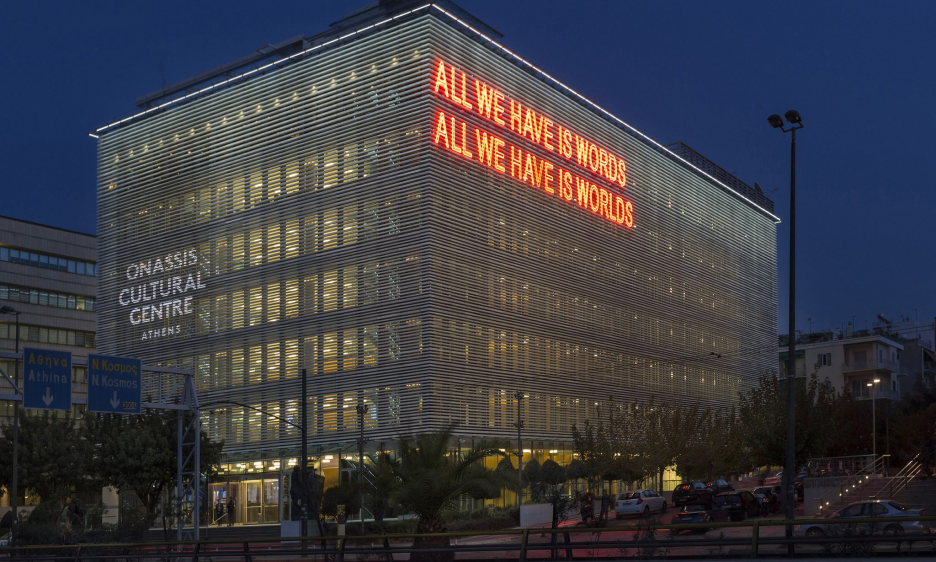Home » Jazz Articles » Live Review » Eve Risser L' ensemble ensemble at Stegi Onassis Cultural Centre
Eve Risser L' ensemble ensemble at Stegi Onassis Cultural Centre

Stegi Onassis Cultural Centre
Athens
March 8, 2019
The Onassis Cultural Foundation and the Stegi site/building in Athens are both offshoots of the Alexander S. Onassis Public Benefit Foundation, a foundation created by ship magnate Aristotle Onassis (1906-1975) to honor the memory of his son Alexander, who died at age 24 in an airplane crash in 1973. The cultural part of the foundation is financed by the business part and is dedicated to culture, education, health and social solidarity. Stegi, meaning 'roof' in Greek, is an impressive multidisciplinary and multicultural art space opened in 2010. Stegi Onassis Cultural Centre presents a pointed choice of Greek and international artists in challenging and illuminating ways to Greek audiences (see current program here). It "offers events across the whole spectrum of the arts, from theater, dance, music, film, and visual arts, to the written word. The Center emphasizes contemporary cultural expression, supporting Greek artists, cultivating international collaborations, and educating children and people of all ages through lifelong learning."
In 2000 the US branch Onassis Foundation USA was started. "For over 19 years, it has been dedicated to culture, community, and education, with projects that can effectively inspire social change and justice across borders. By collaborating with Onassis Stegi in Athens and educational and cultural institutions throughout the Americas, Onassis USA presents theatrical and dance productions, art exhibits, conversations, lectures, and other initiatives, triggering discussions about democratic values, human rights, civil rights, and the ever- changing realities facing today's citizens on a global scale. Onassis Foundation USA runs through two major initiatives, one cultural for the general public through its Onassis Cultural Center New York, and the other educational for scholars and students in partnership with educational institutions through the Onassis Humanities Impact Program."
The group
French pianist Eve Risser, Norwegian vocalist Mari Kvien Brunvoll, Norwegian guitarist Kim Myhr, Romanian violinist/guitarist George Dumitriu and drummer/percussionist Toma Gouband evolved as a performing group during a 2018 residency at Nouvelle Scene National de Cergny-Pontoise. The group made its initial public appearances on the scene in June 2018 at Atelier du Plateau in Paris and then in November at Festival Sons Autonomne in Annecy. Stegi Onassis at Athens then was its third appearance—a bold programming choice for this Pan European combination heading to new directions of improvisational music making.The concert
The group's music took shape in uncommon and miraculous ways that felt like alchemy. Starting from sounds that seemed to exist on their own without purpose it continued with wondrously repetitive and shifting moves that did not give away immediately these seemingly random sounds' determination. The musicians were wandering in ambivalences and minimal tonal gestures, thereby evoking and enabling surprising amalgamations. They playfully juggled the sounds and let them morph to (and along) transitory zones in a delicate interplay of pure explorative joy, expectant suspense and cathartic dissolution. It was more a matter of suggestion and gripping approximation than a matter of straight articulation. In a way it was the opposite of deconstructive approaches. In a game with playful particles something 'known' emerges from unknown and non- determinate zones of sound.There was a certain uniformity in the 'procedure' but there were also mixed cases where elements of 'known' pieces were distorted and transfigured. In the long run, tension and denseness diminished due to sameness of procedures or due to having hitherto worked through something less deeply. Both can be ascribed to the developmental stadium of the group's process that requires further continuing exploration and transformation. The most rewarding was the second piece of the concert with Mari Kvien Brunvoll singing in Norwegian. It was a good example of a well worked through piece and a new song form that was laid out in the germ of some other pieces too. It is a song form that emerges from the above indicated operations and processes.
Both Norwegian musicians are part of a strong and varied tradition of working in this micro-to-macro direction. This collaboration however did not turn out a mere extension of that very tradition. Both, and especially Myhr, are experienced in collaborating with musicians approaching it from other angles. The music of this new group then turned out as an advanced form of mutual understanding, exchange and synthesis.
The musicians
Eve Risser (1982), a highly versatile pianist/flautist, is one of the most venturesome forces of the younger French generation of musicians. Her most audacious and simultaneously endearing enterprise as a leader and composer are her orchestras, first the ten-piece White Desert Orchestra (Les Deux Versants Se Regardent) and its offshoots, the two African versions of the Red Desert Orchestra, the Red Desert Orchestra + Kaladjula band as well as the Red Desert Orchestra + Bambara/Hié/Hié. The orchestras bundle up some of the strongest musicians of the younger generation such as Julien Desprez, Antonin-Tri Hoang, Sylvaine Hélary or Sophie Bernado. On the other side of her musical range we find strong improvisational configurations such as the 'free' trio En Corps with drummer Edward Perraud and bassist Benjamin Duboc, and quite a number of duos. She herself lists seven configurations. In between these two poles you find the five-piece French-Norwegian-Romanian configuration of l'ensemble ensemble. The orchestras also include Norwegian, Dutch and German musicians.Mari Kvien Brunvoll (1984) is a Norwegian vocalist from Bergen. She started to perform ten years ago using little instruments and electronics (not so common then as now). With her vocal performing style, her timbre, phrasing and texture she came with a clear signature of her own. Her vocal approach has some similarities with the loose and edgy phrasing of Björk, with Björk's natural as well as exalted theatre of voice. Cadence and intonation of Brunvoll's singing are deeply rooted in Norwegian language (as that of Björk is rooted in Icelandic language)—also in wordless singing. She makes use of it and emphasizes it in a playful way—including singing in her vernacular Norwegian dialect. She employs a lot of non-straight singing maneuvers by means of various ways of distortion including radical muting her voice's sound. She's a member of the trio Building Instrument and collaborates with Bergen (slide-)guitarist Stein Urheim. Building Instrument's hand-made esthetics glues together traces from various sources in a highly idiosyncratic and original way
Kim Myhr (1981) has been on the road for more than a decade as guitarist, composer and sound tinkerer. A good example of the last is his solo-work You | Me, a work created in the studio by thoughtful overlays of a multitude of sound traces of material created together with percussionists Tony Buck, Ingar Zach and Hans Hulbækmo. The work was recently performed live with the mentioned percussionists and three other guitarists, David Stackenäs, Havard Volden and Adrian Fiskum Myhr at Berlin Jazzfest 2018. Myhr, who has employed different compositional approaches and strategies, has, among others, written two remarkable pieces for Trondheim Jazz Orchestra with vocalists Sidsel Endresen and Jenny Hval involved (Stems and Cages, In the end his voice will be the sound of paper). Myhr works on qualities of sound and texture in a diversity of music such as that of Milton Nascimento and Ram Narayan, transposing it into a distinctive new context and a very unique sound cosmos. Other branches of Myhr's broad creational activity are the Norwegian-Australian trio MURAL with wind player Jim Denley and percussionist Ingar Zach, the group Circadia with David Stackenäs, Joe Williamson and Tony Buck, French collaborations a.o. with drummer Toma Gouband and pianist Benoit Delbecq, Norwegian units and his collaboration with dancers, especially Italian choreographer Francesco Scavetta, and dancer Orfee Schuijt. His compositional, assembling and improvisational sides clearly merge and feed into each other.
George Dumitriu is an award-winning Romanian violinist/guitarist and an Amsterdam resident. He has a strong background in his native folk and classical music as well as in live- electronics as a firm basis of his duo with Turkish vocalist Sanem Kalfa (Dance) and his own unit DUMItRIO with bassist Mattia Magatelli and drummer/cellist Kristjan Kreyčan (Proverb) from Slovenia. He is also part of the Octet of Slovenian pianist Kaja Draksler and the Amsterdam quintet of Romanian clarinetist Alex Simu a.o..
Toma Gouband is a notable French drummer/percussionist and free improviser who has played in a vast variety of collaborations and compositions. Besides Norwegian percussionist Terje Isungset he is one of the few in the field to systematically use all kinds of non-treated natural materials such as stones, boughs, stems etc.. He is featured in vast variety of French, Belgian, Dutch, Norwegian and Australian collaborations. He is a master of lending magical musical forces to natural sound sources.
Συμπέρασμα / symperasma / conclusion
Onassis took up and presented the music of newly formed Southwest-East-Northwest ensemble of improvising musicians that, besides possessing a strong compositional basis, operated in the 'playful particles' mode of music making. It was an exciting experience how abstract particles, micro sounds and distortions amalgamated with elements of folk music and particular folksongs, thereby creating a new, fresh perception of (known) ancient themes. This emerged as an infinite process of approximation. Even when a piece's shape becomes concrete through a longer period of performing, every new performance reveals 'open' features and aspects to work on. Process and outcome form a dialectical unit here, the process of unfolding and emerging is as important as the result. The more the music plays and finds itself, the higher the experiential quality. This is a highly intuitive process based on deeper musical knowledge and skills. In that sense, this concert was an exemplary artistic choice showing a highly relevant segment of current developments in the field that could and should also connect to Greek musicians' work in progress. Moreover, there is a reverse: as a Greek institution/venue is able to—self-evidently -make an exemplary artistic choice, similar efforts of institutions/venues up North and way West towards Greek musicians are rather rare and are still awaiting fulfillment. It entails that North and West should open up to a perspective of real exchange.Selective Discography
Building Instruments: Mangelen Min (Hubro) Stein Urheim: Utopian Tales (Hubro) George Dumitriu/Sanem Kalfa: Dance (Dumitriu&Kalfa) Kim Myhr: You | Me (Hubro) Eve Risser White Desert Orchestra: Les Deux Versants Se Regardent (Clean Feed) Trio En Corps: Generations (Dark Tree Records) Eve Risser/Marcelo Dos Reis: Timeless (JACC Records)Tags
Live Reviews
Eve Risser
Henning Bolte
Greece
Mari Kvien Brunvoll
Kim Myhr
George Dumitriu
Toma Gouband
Julien Desprez
Antonin Tri-Hoang
Sylvaine Hélar
Sophie Bernado
Edward Perraud
Benjamin Duboc
Tony Buck
Ingar Zach
Hans Hulbækmo
David Stackenas
Havard Volden
Adrian Myhr
Sidsel Endresen
Jenny Hval
Milton Nascimento
Ram Narayan
Jim Denley
Joe Williamson
Benoit Delbecq
Francesco Scavetta
Orfee Schuijt
Sanem Kalfa
Mattia Magatelli
Kristjan Kreyčan
Kaja Draksler
Alex Simu
PREVIOUS / NEXT
Support All About Jazz
 All About Jazz has been a pillar of jazz since 1995, championing it as an art form and, more importantly, supporting the musicians who make it. Our enduring commitment has made "AAJ" one of the most culturally important websites of its kind, read by hundreds of thousands of fans, musicians and industry figures every month.
All About Jazz has been a pillar of jazz since 1995, championing it as an art form and, more importantly, supporting the musicians who make it. Our enduring commitment has made "AAJ" one of the most culturally important websites of its kind, read by hundreds of thousands of fans, musicians and industry figures every month.























